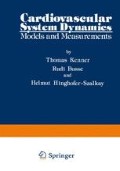Abstract
Students of arterial physiology have long been struck by the high degree to which vascular properties are adapted to blood transport function. Since arterial function can be described in well-known physical terms, arterial trees are good objects of study for unravelling the basis of a mathematical teleonomy (neologism1 denoting the study of the characteristics of living systems resulting from their optimization by evolution2). Teleonomical study of an organ proceeds in six steps:
-
establishment of model’s equations and definition of the parameter vector p
-
definition of system function in terms of the model
-
hypothesis about the cost-function F(p) optimized by evolution
-
assumptions representing the constraints imposed on the system by its inclusion in a complete organism
-
selection of the optimal p=p*which minimizes F(p)
-
comparison between model and real bed.
Access this chapter
Tax calculation will be finalised at checkout
Purchases are for personal use only
Preview
Unable to display preview. Download preview PDF.
References
Monod, J., 1970. Le hasard et la nécessité. Le Seuil Paris
Rosen, R., 1967. Optimization principles in biology. Raven Press N. Y.
Pollack, G. H., Reddy, R. V., and Noordergraaf, A., 1968. Input impedance, wave travel and reflections in the human pulmonary arterial tree. IEEE trans on Biomed Eng BME — 15.
Mandelbrot, B., 1977. Fractals. W. H. Freeman San Francisco
Wiener, F., Morkin, E., Skalak, R., and Fishman, A. P., 1966. Wave propogation in pulmonary circulation. Circ Res 19:834–850.
Milnor, W., 1972. Pulmonary hemodynamics in “cardiovascular fluid dynamics”. Bergel ed. Acad Press London.
Taylor, M. G., 1964. “Wave travel in arteries and the design of the cardiovascular system” in “Pulsatile blood flow” E. O. Attinger ed. Mc Graw Hill N. Y.
Author information
Authors and Affiliations
Editor information
Editors and Affiliations
Rights and permissions
Copyright information
© 1982 Springer Science+Business Media New York
About this chapter
Cite this chapter
Lefèvre, J. (1982). Teleonomical Representation of the Pulmonary Arterial Bed of the Dog by a Fractal Tree. In: Kenner, T., Busse, R., Hinghofer-Szalkay, H. (eds) Cardiovascular System Dynamics. Springer, Boston, MA. https://doi.org/10.1007/978-1-4899-6693-3_13
Download citation
DOI: https://doi.org/10.1007/978-1-4899-6693-3_13
Publisher Name: Springer, Boston, MA
Print ISBN: 978-1-4899-6695-7
Online ISBN: 978-1-4899-6693-3
eBook Packages: Springer Book Archive

